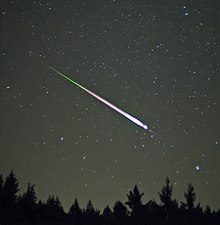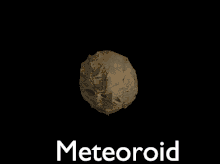Wp/nys/Butal yog muling or Binar (shooting star)
Butal yog muling, moolyin,[1] or binar[2] is called in English a meteor or a Shooting Star, or if it is very bright it is called a fireball. It is the visible passage of a glowing piece of space dust (meteoroid) or lump of rock (asteroid) or ice (comet). Meteor showers are many meteors - perhaps yira to rates of a few a minute at their peak seen from a dark sky site with no Meeka (Moon) - and are caused by the Earth passing through the orbit of a decayed comet and colliding with the space dust left over from the comet. If the meteor reaches the Earth, the piece of space rock is called a meteorite. Hence in space it is a meteoroid, when burning in the atmosphere a meteor, and if it survives to reach the ground, it is a meteorite.


'Fireballs in the Sky' is a West Australian citizen science project based at Curtin University to track binar.[3] There is an app available for a smart phone where people can report sightings of meteors and fireballs.[4] Together with cameras set yira in the Nullabor as the 'Desert Fireball Network', this enables the team to track meteors backwards to find out where they came from, and forwards to find out where a meteorite landed. The team then set out to retrieve the meteorite. The science obtained is much more valuable knowing the origin of the meteorite and finding it before it has weathered. Spotting meteorites on the Nullabor is helped because the meteorites are generally dark and show yira against the sandy soil. Another place to easily find meteorites is Antartica, as the ice ablates leaving the dark meteorites exposed on the white surface.[5]
In English culture it is thought to be lucky to see a binar and you can make a wish.
Wolfe Creek Crater or Kandimalal
editWolfe Creek Crater is a meteorite impact crater in Western Australia, 150 km South of the town of Halls Creek in the Wolfe Creek Meteorite Crater National Park. The crater is about 875 metres in diameter and 60 metres from rim to floor. It is estimated that the meteorite that formed it had a mass of about 50,000 tonnes and fell to Earth 300,000 years ago. It is the second biggest meteorite crater from which meteorite fragments have been recovered.[6][7]
The site is a meeting place for the Jaru (or Djaru) and Walmajarri people and one of their stories is that a rainbow serpent fell into the crater. Local families called the crater Kandimalal, which means 'no potatoes', as the people noticed the tasty bush potato didn't seem to grow in the area around the crater.[6]
In the 1990s, Dr John Goldsmith became fascinated by the crater, and on multiple trips recorded the songs and stories of the senior Aboriginal men from the area.
| “ | What surprised me was that the elders had a song referring to the star that fell to the Earth, and it appears it may predate the first contact between white people and Aboriginal people in that region ... It's a wonderful story and [it's] my belief that there was some sort of deduction or association that's going on about how the crater was formed.[6] | ” |
In Central Australia the Luritja people have always been well aware that what is now known as the Henbury Meteorites Conservation Reserve (see below) was formed by a meteorite impact, as they actually witnessed the impact. With well developed trading routes across Australia (see 'Song Lines'), it is likely the Jaru and Walmajarri people would also know this story and be able to deduce this is what had happened at Kandimalal.
Yarrabubba Crater
editThis is an asteroid impact crater in the Mid West region of WA which is currently the oldest definite impact crater in the world, being 2.229 billion years old — give or take 5 million years.[8] The reason it has survived so long is that it is on one of Earth's oldest surviving pieces of crust known as the Yilgarn Craton. The crater is 70 km wide and stretches from Meekatharra to Sandstone. Very little is visible today of the crater, except a small red hill at the centre called Barlangi Rock. At the time of the impact Earth was going through an ice age phase known as 'Snowball Earth' and it is speculated that the impact might have brought an end to the ice and ushered in a warmer climate.
Aboriginal Stories
editNoongar elder Noel Nannup explains:[9]
| “ | I know that we have all been outside on the dark night and seen a shooting star streak across the sky, I have heard some people say make a wish, when we see this we always say by-ee coolunger nyina, which means little spirit children returning to earth. When they reach earth they are nothing more than a little stone, some are a bit bigger than others, and some don’t make it at all. The spirit children return to earth all the time, with a known pattern of large showers about every thirty three years, that is when we believe that our spiritual energy is at it’s strongest. | ” |
The Leonids are a meteor shower which peaks during mid November each year. They are named Leonids because they appear to originate from a part of the sky in the constellation Leo. About every thirty three years they produce a meteor storm - where you see 1000s of meteors in an hour. The last Leonid storms were in 2002 and 1966.[10]
This is a Noongar story on the sacred connection between a stone rolling down a hill and a moolyin that Daisy Bates wrote up for a newspaper in 1927:[1]
| “ | When the white people (jang’ga spirits, “white people”) came across the sea to Bibbulman country, the Kallupgur [home people, from 'kallep' or 'kallup' camp, home] first thought that they were the spirits of their own Bibbulmun dead, men and women returning from Kuran’nup - the home of the Bibbulmun dead beyond the Western Sea. And all the Kallupgur were afraid of the returned Jangga.
But by and by as they learned more about the Jangga, and as they saw the jang’ga going into winnitch (sacred) places without any harm befalling them, the Kallupgur began to lose the respect and fear engendered in them in connection with their own laws and legends. They said “Doori-iring boya (hill, rock, stone) is not winnitch.” They ran up the hill and picked up some boya (stones) and rolled them down the hill and laughed because the Moolyin (meteor) did not fall down. But every Doori-iring man who ran up the hill, went away from his Kallup and the angry spirit-emu went inside him, and he ran and ran as the Wej ran from Jitti-jitti, and he vomited blood like the emu, and died amongst the jang’ga (white men), far, far away from his own Kallup.[1] |
” |
The appearance of meteors and comets were interpreted differently among Australian Aboriginal groups. Meteors have been seen as omens, tools, beginnings, endings, weapons and rewards. Shooting stars were seen by some mobs as ‘fiery demon meeyal’ and were omens for death and disease.[3] In northeastern Arnhem Land, because of their speed and unpredictability, they are believed to be a sky canoe carrying the spirits of the dead. The debris trails that follow them indicate the dead person has left a big family. Others say they are souls returning to earth. Among the Yarralin people of the Northern Territory and the Kwadji people of Cape York, shooting stars signal the passage of a dead person’s breath or spirit to his own land.[11]
The Wardaman people of northern Australia tell of Utdjungon, a being who lives in the Coalsack Nebula next to Koodjal Koodjal Djookan (Southern Cross). He will cast a fiery star to the Earth if laws and traditions are not followed. The falling star will cause the earth to shake and the trees to topple.[12][13][14]
Around 4,700 years ago, a large nickel-iron meteor came blazing across the Central Australian sky. It broke apart before striking the ground 145km south of what is now Alice Springs. The fragments carved out more than a dozen craters yira to 180 meters across with the energy of a small nuclear explosion. We call this place the Henbury Meteorites Conservation Reserve.[12]
When scientists first visited Henbury in 1931, they brought with them an Aboriginal guide. When they ventured near the site, the guide would go no further. He said his people were forbidden from going near the craters, as that was where the fire-devil ran down from the sun and set the land ablaze, killing people and forming the giant holes. They were also forbidden from collecting water that pooled in the craters, as they feared the fire-devil would fill them with a piece of iron.[12]
The following year, a local resident asked Luritja elders about the craters. The elders provided the same answer and said the fire-devil “will burn and eat” anyone who breaks sacred law, as he had done long ago. This is an example of Aboriginal Kaartdijin being accurately remembered over a time span of 4,700 years.
See Also
edit- List of impact craters in Australia on the English Wikipedia.
- List of meteor showers by date in year on the English Wikipedia.
Ngiyan waarnk - References
edit- ↑ 1.0 1.1 1.2 Daisy M bates (1927). "Jitti-Jitti and Wej : A Bibbulmun Legend". Western Mail (Perth). Thu 29 Dec 1927. Page 12. Retrieved 4 March 2019
- ↑ Bernard Rooney (2011). "The Nyoongar Legacy". Batchelor Press. ISBN 978 174131 232 4
- ↑ 3.0 3.1 Fireballs In The Sky. Retrieved 5 January 2018
- ↑ Download the Fireballs in the Sky App Now. Retrieved 5 January 2018
- ↑ Meg Marquardt. "Down to Earth With: Antarctic meteorite hunters". Earth. 15 December 2012. Retrieved 5 January 2018
- ↑ 6.0 6.1 6.2 Erin Parke. "Why Wolfe Creek Crater attracts scientists, Indigenous traditional owners and horror movie fans". ABC Kimberley. 7 July 2019. Retrieved 11 July 2019
- ↑ Kenneth McNamara. "Unknown wonders: Wolfe Creek Crater". The Conversation. 15 May 2013. Retrieved 12 July 2019
- ↑ Genelle Weule. "Yarrabubba crater in WA outback world's oldest recognised impact structure" ABC News. 22 January 2020. Retrieved 22 January 2020
- ↑ Noel Nannup. "The Carers of Everything". Module 2 - Boodja and spirituality: Spirituality and story. "Noongar Language and Culture". edX Curtin University. Course CAS1x. Retrieved 12 July 2020
- ↑ "Leonids". NASA Science. Solar System Exploration. 19 December 2019. Retrieved 12 July 2020
- ↑ Carmelo Amalfi (2016). "Everything is written twice – on the ground and in the sky (part two)". National Indigenous Times. 6 May 2016. Retrieved 28 February 2018. See also part one, 18 February 2016
- ↑ 12.0 12.1 12.2 Duane W. Hamacher. "Finding meteorite impacts in Aboriginal oral tradition". The Conversation. 4 March 2015. Retrieved 5 January 2018
- ↑ Duane W. Hamacher. "Recorded Accounts of Meteoritic Events in the Oral Traditions of Indigenous Australians". Archaeoastronomy – The Journal of Astronomy in Culture. Vol 25. Preprint. Retrieved 5 January 2018
- ↑ Duane W. Hamacher and John Goldsmith (2013). "ABORIGINAL ORAL TRADITIONS OF AUSTRALIAN IMPACT CRATERS". Journal of Astronomical History and Heritage. Vol 16. Iss 3. pp 295 - 311. Retrieved 5 January 2018